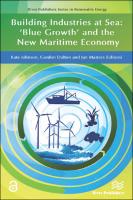Building Industries at Sea - ‘Blue Growth’ and the New Maritime Economy
Proposal review
| dc.contributor.editor | Johnson, Kate | |
| dc.contributor.editor | Masters, Ian | |
| dc.contributor.editor | Dalton, Gordon | |
| dc.date.accessioned | 2022-11-28T16:04:12Z | |
| dc.date.available | 2022-11-28T16:04:12Z | |
| dc.date.issued | 2018 | |
| dc.identifier | ONIX_20221128_9781000794946_32 | |
| dc.identifier.uri | https://library.oapen.org/handle/20.500.12657/59748 | |
| dc.description.abstract | Throughout the world there is evidence of mounting interest in marine resources and new maritime industries to create jobs, economic growth and to help in the provision of energy and food security. Expanding populations, insecurity of traditional sources of supply and the effects of climate change add urgency to a perceived need to address and overcome the serious challenges of working in the maritime environment. Four promising areas of activity for ‘Blue Growth’ have been identified at European Union policy level including Aquaculture; Renewable Energy (offshore wind, wave and tide); Seabed Mining; and Blue Biotechnology. Work has started to raise the technological and investment readiness levels (TRLs and IRLs) of these prospective industries drawing on the experience of established maritime industries such as Offshore Oil and Gas; Shipping; Fisheries and Tourism. An accord has to be struck between policy makers and regulators on the one hand, anxious to direct research and business incentives in effective and efficient directions, and developers, investors and businesses on the other, anxious to reduce the risks of such potentially profitable but innovative investments.The EU H2020 MARIBE (Marine Investment for the Blue Economy) funded project was designed to identify the key technical and non-technical challenges facing maritime industries and to place them into the social and economic context of the coastal and ocean economy. MARIBE went on to examine with companies, real projects for the combination of marine industry sectors into multi-use platforms (MUPs). The purpose of this book is to publish the detailed analysis of each prospective and established maritime business sector. Sector experts working to a common template explain what these industries are, how they work, their prospects to create wealth and employment, and where they currently stand in terms of innovation, trends and their lifecycle. The book goes on to describe progress with the changing regulatory and planning regimes in the European Sea Basins including the Caribbean where there are significant European interests. The book includes:• Experienced chapter authors from a truly multidisciplinary team of sector specialisms• First extensive study to compare and contrast traditional Blue Economy with Blue Growth• Complementary to EU and National policies for multi-use of maritime space | |
| dc.language | English | |
| dc.subject.classification | thema EDItEUR::T Technology, Engineering, Agriculture, Industrial processes::TQ Environmental science, engineering and technology | en_US |
| dc.subject.classification | thema EDItEUR::T Technology, Engineering, Agriculture, Industrial processes::TH Energy technology and engineering::THV Alternative and renewable energy sources and technology | en_US |
| dc.subject.other | Environmental science, engineering and technology | |
| dc.subject.other | Alternative and renewable energy sources and technology | |
| dc.title | Building Industries at Sea - ‘Blue Growth’ and the New Maritime Economy | |
| dc.type | book | |
| oapen.identifier.doi | 10.1201/9781003337430 | |
| oapen.relation.isPublishedBy | 7b3c7b10-5b1e-40b3-860e-c6dd5197f0bb | |
| oapen.relation.isFundedBy | 3983007a-5726-4f1e-b9df-3fbc771f2916 | |
| oapen.relation.isbn | 9781000794946 | |
| oapen.relation.isbn | 9788793609266 | |
| oapen.relation.isbn | 9781003337430 | |
| oapen.imprint | River Publishers | |
| oapen.pages | 514 | |
| oapen.grant.number | [...] | |
| peerreview.anonymity | Single-anonymised | |
| peerreview.id | bc80075c-96cc-4740-a9f3-a234bc2598f1 | |
| peerreview.open.review | No | |
| peerreview.publish.responsibility | Publisher | |
| peerreview.review.stage | Pre-publication | |
| peerreview.review.type | Proposal | |
| peerreview.reviewer.type | Internal editor | |
| peerreview.reviewer.type | External peer reviewer | |
| peerreview.title | Proposal review | |
| oapen.review.comments | Taylor & Francis open access titles are reviewed as a minimum at proposal stage by at least two external peer reviewers and an internal editor (additional reviews may be sought and additional content reviewed as required). |

